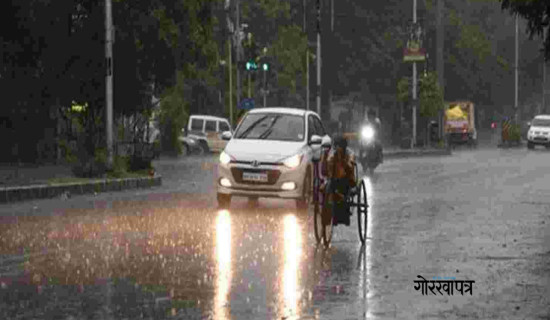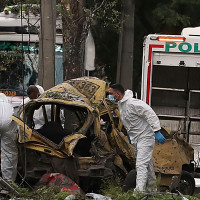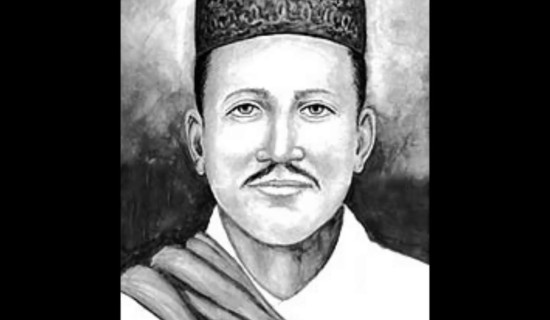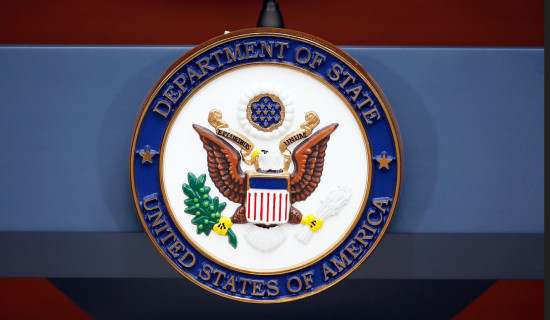- Saturday, 23 August 2025
Man halted from crossing over US-Mexico border wall
Nogales, Ariz. July 26: Inside an armored vehicle, an Army scout uses a joystick to direct a long-range optical scope toward a man perched atop the U.S.-Mexico border wall cutting across the hills of this Arizona frontier community.
The man lowers himself toward U.S. soil between coils of concertina wire. Shouts ring out, an alert is sounded and a U.S. Border Patrol SUV races toward the wall — warning enough to send the man scrambling back over it, disappearing into Mexico.
The sighting Tuesday was one of only two for the Army infantry unit patrolling this sector of the southern border, where an emergency declaration by President Donald Trump has thrust the military into a central role in deterring migrant crossings between U.S. ports of entry.
"Deterrence is actually boring," said 24-year-old Army Sgt. Ana Harker-Molina, voicing the tedium felt by some fellow soldiers over the sporadic sightings.
Still, she said she takes pride in the work, knowing that troops discourage crossings by their mere presence.
"Just if we're sitting here watching the border, it's helping our country," said Harker-Molina, an immigrant herself who came from Panama at age 12 and became a U.S. citizen two years ago while serving in the Army.
U.S. troop deployments at the border have tripled to 7,600 and include every branch of the military — even as the number of attempted illegal crossings plummet and Trump has authorized funding for an additional 3,000 Border Patrol agents, offering $10,000 signing and retention bonuses.
The military mission is guided from a new command center at a remote Army intelligence training base alongside southern Arizona's Huachuca Mountains. There, a community hall has been transformed into a bustling war room of battalion commanders and staff with digital maps pinpointing military camps and movements along the nearly 2,000-mile border.
Until now border enforcement had been the domain of civilian law enforcement, with the military only intermittently stepping in.
But in April, large swaths of border were designated militarized zones, empowering U.S. troops to apprehend immigrants and others accused of trespassing on Army, Air Force or Navy bases, and authorizing additional criminal charges that can mean prison time.
At Nogales, Army scouts patrolled the border in full battle gear — helmet, M5 service rifle, bullet-resistant vest — with the right to use deadly force if attacked under standing military rules integrated into the border mission. Underfoot, smugglers for decades routinely attempted to tunnel into stormwater drains to ferry contraband into the U.S.
Naumann's command post oversees an armada of 117 armored Stryker vehicles, more than 35 helicopters and a half-dozen long-distance drones that can survey the border day and night with sensors to pinpoint people wandering the desert.
Marine Corps engineers are adding concertina wire to slow crossings, as the Trump administration reboots border wall construction. Meanwhile, the rate of apprehensions at the border has fallen to a 60-year low.
Naumann says the fall-off in illegal entries is the "elephant in the room" as the military increases pressure and resources aimed at starving smuggling cartels — including Latin American gangs recently designated as foreign terrorist organizations.
He says it would be wrong to let up, though, and that crossings may rebound with the end of scorching summer weather.
The Trump administration is using the military broadly to boost its immigration operations, from guarding federal buildings in Los Angeles against protests over ICE detentions, to assisting Immigration and Customs Enforcement in Florida to plans to hold detained immigrants on military bases in New Jersey, Indiana and Texas.
The militarized zones at the border sidestep the Posse Comitatus Act, an 1878 law that prohibits the military from conducting civilian law enforcement on U.S. soil.
Michael Fisher, a security consultant and former chief of the Border Patrol from 2010-2016, calls the military expansion at the border a "force multiplier" as Border Patrol agents increasingly turn up far from the border.
In 1997, an 18-year-old U.S. citizen was shot to death while herding goats by a Marine Corps unit on a border anti-drug patrol in the remote Big Bend Region of western Texas. Authorities say Esequiel Hernandez had no connection to the drug trade and was an honor student.
The shooting stoked anger along the border and prompted an end to then-President Bill Clinton's military deployment to the border.
In New Mexico, the latest restrictions barring access to militarized zones have made popular areas for hunting, hiking and offroad motorsports off-limits for recreation, leading to an outcry from some residents.
At daybreak Wednesday, Border Patrol vehicles climbed the largely unfenced slopes of Mt. Cristo Rey, an iconic peak topped by a crucifix that juts into the sky above the urban outskirts of El Paso and Mexico's Ciudad Juárez — without another soul in sight. (AP)
















